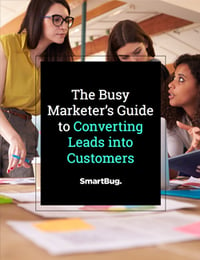
By Julia Bye
You know that feeling when you cruise through a string of green lights with perfect timing? Or when a new line opens up at the grocery store right when you’re ready to check out?
Feels pretty good, doesn’t it?
What if you could give that feeling to your potential customers by delivering a perfectly targeted and tailored marketing message right when they’re searching for a solution just like the one your company offers?
Marketers are increasingly able to find this digital sweet spot using an approach called intent-based marketing. This form of marketing uses data that focuses on customers’ intentions based on their web activity. One Demand Gen Report survey found that 80 percent of companies that are already using intent data have noted that it has helped them with lead prioritization and scoring.
So how does intent-based marketing work, and how can your team leverage resources like ZoomInfo to boost your marketing with perfectly timed and tailored messages? Let’s dive in.
Intent-Based Marketing: What You Need to Know
As customers navigate the internet and visit websites to learn more about how to solve their business problems, they’re leaving behind a digital trail consisting of web searches, cookies, downloads, form submissions, and social media interactions.
Framed differently, this data demonstrates a potential customer’s interest in or intention to buy a product or service. Compiled from a business’s own data sources or via platforms such as ZoomInfo that organize and deliver this data from their participating partners, marketers can use this data to better identify who their potential customers are, using their behavior to increase the chance of success.
More specifically, there are two primary types of intent data:
First-Party Intent Data
This data is generated from the interactions and engagements that occur on a company's own digital properties, such as its website or mobile app. It includes data on which pages a user visited, which products or services they viewed, and their behavior on the site. It provides insights into the specific interests and actions of known prospects.
Third-Party Intent Data
Third-party intent data is collected from external sources, such as ZoomInfo or industry-specific platforms. Third-party intent data offers a broader view of the market and can identify potential leads who haven't interacted with a company's digital assets. ZoomInfo, for example, compiles the following types of consumption data in near-real time:
- Product reviews
- Infographics and blogs
- Product comparisons
- Message boards (e.g., Quora.com)
- Case studies
- General news
How Intent Data Makes a Difference
Ask any seasoned marketer what their ideal customer profile (ICP) is, and they’ll likely be able to quickly rattle off their key personas, qualities, and pain points. But how do you know if your ICP knows who you are?
Intent data helps your marketing and sales teams cut through the noise and move away from a “numbers game” to one in which your potential customers are more receptive to receiving a contact from your company. Marketers and sales teams use intent data to:
- Identify prospects: By analyzing intent data, businesses can identify potential customers who are actively researching products or services related to their offerings.
- Personalize outreach: Understanding a prospect's intent allows for more personalized and timely marketing and sales efforts—for example, sending targeted content or offers that align with a prospect's interests.
- Prioritize leads: Intent data helps with lead scoring and lead prioritization. Prospects showing strong intent are often considered more valuable and may receive more immediate attention.
- Improve content strategy: Marketers can use intent data to refine their content strategy by focusing on topics and themes that are of high interest to their target audience.
4 Steps to Building an Intent-Based Approach with ZoomInfo
With so many benefits to discover, we’ll cut to the chase and give you the four key steps to building your own intent-based marketing approach with a platform like ZoomInfo:
Step 1: Build and Save Intent Topic Searches
The first step, building and saving intent topic searches, is when your team shapes the type of data that will feed your intent-based approach.
Work closely with your sales and marketing teams to identify the behavioral signals or pain points that have indicated that potential customers were receptive to a sales call, demo, or personalized product discussion. A good place to start is by interviewing your sales team to find out what common questions they hear in the sales process. Topics such as “increasing productivity,” “boosting collaboration,” “optimization,” or “user engagement” can be good starting points.
Step 2: Find and Refine Your Search-Based Contacts
The second step builds on the first by adding intent-focused keywords to refine the intent data you’ll be reviewing.
This intent data can be organized by:
- Persona or contact-specific search criteria
- The amount of contact information ZoomInfo has (e.g., direct phone, email, both direct phone and email, and so on)
- The contact’s ZoomInfo confidence score (start with 85-99 percent)
These topics and searches can then be combined to build initial intent-based lists from ZoomInfo.
SmartBug tip: Avoid using demographic data and job titles as search criteria because they are not a strong indicator of a customer’s intent.
Step 3: Determine Who to Exclude
As with other persona-based marketing efforts, you can maximize the return on your marketing investment by excluding the actions and indicators that present themselves in the initial lists that do not align with your product or solution.
Similarly, if a contact is already in your CRM from a prior interaction, don’t waste a ZoomInfo credit on that contact as you plan your campaigns.
Step 4: Personalize Campaigns Based on Your Target List
The final step is where the digital rubber hits the road. With your intent-based data as a guide, turn personalized key messages by persona and buyer’s journey stage into tailored touchpoints, lead nurtures, and resources that help your brand to stand out from the competition.
Remember that none of these steps is a one-and-done activity. Further refine, refresh, and re-engage with your newfound intent-based contacts on a quarterly or yearly basis, and continue to watch your sales cycles and costs per sale drop over time.
Bringing It All Together
Intent-based marketing is an exciting way to better target and understand your ICPs by using their own research data to your advantage. Once it is established, intent-based marketing can be a nice complement to your team’s other marketing efforts, helping your brand reach new audiences and furthering your understanding of what resonates most with your target audience.

About the author
Julia Bye is a Minneapolis-based Director, Customer Success Strategy for SmartBug Media. With a background in agency marketing, she specializes in lead generation, lead nurturing, sales enablement, and content-based tactics that focus on her client's sales and marketing goals. Read more articles by Julia Bye.










